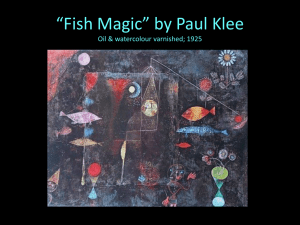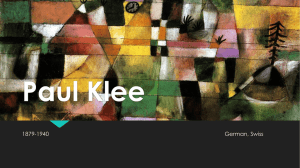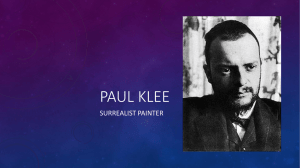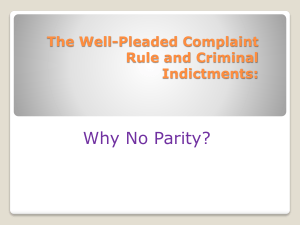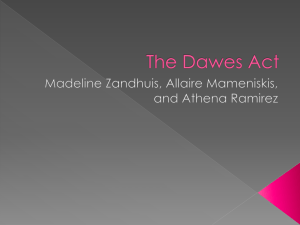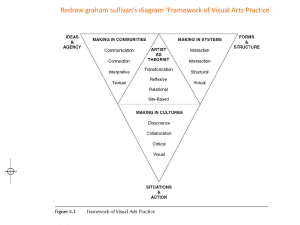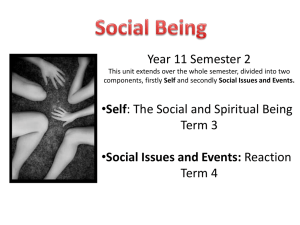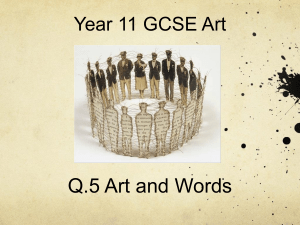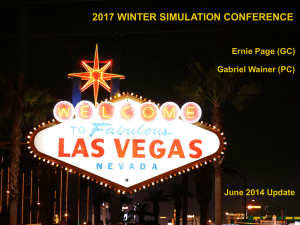Cy Twombly - Scurlock ARt
advertisement
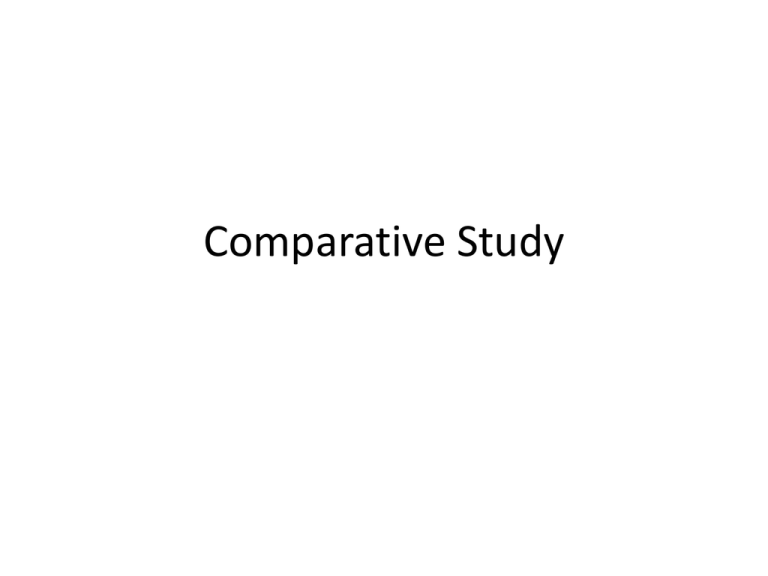
Comparative Study A Comparative Study The following study analyzes the formal qualities, the function and purpose and the cultural significance following art work: • Quattro Stagioni: Autunno, 1993-5 by Cy Twombly • Sunflower, 1980 by Stefan Bertalan • Hermitage, 1917 by Paul Klee Following the comparative study is the interpretation of student art work and analysis of the influence and connections made by the artist cited in the study. Cy Twombly (American, 1928-2011) • • • Quattro Stagioni: Autunno 1993-5 House paint, oil, crayon, and pencil on canvas Cy Twombly was a second generation abstract expressionist. In the late 1950’s, he moved from New York City to Rome where he was drawn in by the architecture and landscape of Italy. In Quattro Stagioni, Part III: Autunno translated The Four Seasons, Part III: Fall was part of a series of paintings Twombly made to denote the seasons. The composition of the piece follows the rule of thirds. The bottom two thirds of the piece are filled with large explosions of paint that are reminiscent of a child’s drawing. The cluster of random marks at the bottom of the painting reminds me of a flock of birds. Twombly could be alluding to the migration of birds in the fall. The viewers attention is drawn to the left hand corner where there is only one black gesture which helps to balance out the composition. The frenetic marks give the piece a strong sense of movement and rhythm that carries your eye around the picture plane. Having most of the emphasis on the bottom portion of the canvas also gives the viewer the sense of a landscape which would be indicative of Twombly’s love of Italian landscape. The drips and build up of paint give the piece weight and help balance the free floating forms. The palette is made up of dark blues, purples, blacks and intense reds on a white ground with a hint of yellow. The richness of the color indicates the height of the fall season and the harvest of grapes and creation of wine. I find the most interesting part of Twombly’s work, his use of writing as a form of mark making. You can see in the top portion of the painting encrypted messages embedded in the layers. The art historian John Berger is quoted as saying, Twombly “visualizes with living colors the silent space that exists between and around words” (Berger). Cy Twombly (American, 1928-2011) Quattro Stagioni, Part III: Autunno is part of Twombly’s series that explores the seasons, cycles, and nature. The Four Seasons are a metaphor for the passing of time and rebirth and the inevitable cycle of life. Twombly’s paintings are about process and discovery as he states "It's not described, it's happening … The line is the feeling” (Twombly). Like the many surrealist artists, Twombly believes in psychic automatism, the belief that the artist does not control the creation of the work, but allows the creation to occur itself. In the 1950’s Twombly became very interested in tribal art and primitivism. He went on to adopt the simple directness he observed in tribal art. The sense of bold and immediate mark making is evident in all of the paintings that are part of the Four Seasons series. Often drawing his inspiration from European literature and classical culture, Twombly’s Quattro Stagioni, Part III: Autunno Twombly includes parts and pieces of poems. For instance, poems by Rainer Maria Rilke and Giorgos Seferis are embedded in the marks on his paintings. Twombly ‘s love of classical art history is evident in his use of the Four Seasons theme which is used many times as a metaphor in the history of art. • Quattro Stagioni: Inverno 1993-5 House paint, oil, crayon, and pencil on canvas Cy Twombly (American, 1928-2011) Installation of the Four Seasons at the Tate Modern in London When considering Quattro Stagioni: Autunno 1993-5 and all of Cy Twombly work one has to look at his important role in the art world’s historical context. In 1950 and 1951, he studied at the Art Students League in New York. There, he met Robert Rauschenberg, who was responsible for introducing him to some of the first generation abstract expressionist such as Wilhelm De Kooning, Franz Kline and Jackson Pollock. In 1951, he was conscripted into the army where he served as a cryptographer. His method of encoding of language in his work, was influenced by his brief employment as a cryptologist. Returning to New York in 1953, he was beginning to be considered one of the prominent figures in the Abstract Expressionist movement. In 1957, he moved to Gaeta in southern Italy were he was in closer proximity to the myths, literature and classical art history that often appeared as cryptic passages in his work. I think it is important to note in the 1930’s and 40’s many artists left Europe due to WWII and immigrated to the United States of America, bringing with them the influence of modernism which at the time was more progressive in Europe. Due to WWII, the center of the Art World moved from Paris to New York. Twombly, who was one of the members of the New York School, reversed this trend by making Europe his main residence even though he often returned to the States and was included in many exhibitions in the US. His work was unique in the sense that he combined the artistic influences of classical Europe with the frenetic energy of the American Abstract Expressionist movement. Stefan Bertalan (Romanian,1930-Present) Sunflower, 1980, page chalk, felt-tip pen and black ink on paper Doppelseite, je 54,9 x 32,5 cm - double page, each 21.6 x 12.8in. This past summer, I traveled to Italy with a school group and fortunately part of our tour was a visit the Venice Biennale, one of the most important exhibitions of contemporary art in the world. At the exhibition, I was introduced to the work of the Romanian artist Stefan Bertalan. Bertalan has been a part of the Neo-Avant-Garde Movement in Romania since the 1960’s. He has a history of projects and installations that are conceptual in nature. The piece Sunflower is a part of a series by Stefan Bertalan entitled I Lived for a 130 Days with a Sunflower Plant. According to Massimiliano Gioni the curator of the Venice Biennale “Bertalan studied a sunflower plant for its entire life cycle, from the first germination of its seed through its eventual death, documenting its evolution each day through photographs, drawings, and a written diary.” (page 49) One of the many drawings from his Sunflower series to the left looks as if it could be a pages from a book. Bertalan juxtaposes gestural drawing of a monochromatic sunflower on the left with a painted one on the right. He does not seem to have a concern for portraying the colors of the plants accurately on the right but has chosen to use a mostly blue palette that is as ascetically pleasing. The margins are filled with notes and calculations that move your eye around the composition. The physicality of the writing goes beyond what is being recorded and becomes more important to the mark making process. The spontaneity of the gesture in the drawings make the pieces feel very free and some what abstract. In contrast, the renderings also reference the highly technical botanical drawings that were popular in the eighteenth century. Stefan Bertalan (Romanian, 1930-Present) • Sunflower, 1980 chalk, felt-tip pen, ball pen and pencil on paper 56,5 x 36,8 cm - 22.2 x 14.5 in. Not only did Bertalan’s project revolving around a sunflower produce a number of final drawings but also a record of the process which included the decay of the plant and his daily recordings. In his investigation which resulted in several pieces entitled Sunflower, Bertalan wanted to convey the concept that a single organism and its function can serve as a metaphor for the world at large. It is important to note that this project was more about the everyday experience an not the visual record that exists in the end. The final pieces that were generated from Bertalan Sunflower project are in there own right beautiful drawings. I think the everyday actions of the artist observing the decay and disappearance of the plant speaks to the complexities of the human condition . The work has connections to performance art as well botanical studies a more traditional art form. Even though the work was made in the 1980’s it relates directly to current trends in art for example to combine different disciplines such as art and science. The pieces are timely in there reference to modern society with the increased interest in the changes occurring in the natural world, and in the role plants play in helping us sustain a healthy environment. Stefan Bertalan (Romanian, 1930-Present) I Lived for a 130 Days with a Sunflower Plant and the Structure of Snails (seen below) two of Bertalan’s series were made in the 1980’s in Communist Romania. At this time, Romanians were experiencing food shortages and unrest due to the fall of other Communist regimes in Eastern Europe. According to the Romanian philosopher and art historian “The general social state of poverty, complacency, degradation and disengagement, together with the material and the cultural decay is probably the most striking characteristic of the Romanian environment during the '80s. [...]” (189, Erwin Kessler). Knowing the context in which Bertalan created the Sunflower series brings even more significance to the metaphor of decay that is a predominant theme in his work. It is interesting that living in the shadow of the rule of Communism influenced Bertalan in that he chose to state his case in a very simple and natural forms. The implication of his pieces is subtle but at the same time powerful in its intent. Bertalan’s decay of a sunflower represents the collapse of society, but at the same time gives hope with the germination of new seeds which represent rebirth and change. • Snails, 1980 chalk, felt-tip pen, ball pen and pencil on paper 56,5 x 36,8 cm - 22.2 x 14.5 in. Paul Klee (German, 1879–1940) Hermitage. 1918. Watercolor on chalk ground. 18.3 x 25.4 cm In 1914, Paul Klee visited Tunisia in North Africa and was overwhelmed with the color created by the light of Mediterranean Sea and at that time he was quoted as saying “Color possesses me. I don't have to pursue it. It will possess me always, I know it. That is the meaning of this happy hour: Color and I are one. I am a painter.” (1914, Klee) As a result of his trip, Klee’s work started to become more abstract. The piece to the left, made after his trip to Tunisia, is saturated with a beautiful blue, reminiscent of the color of the Mediterranean Sea. The piece is covered with several drawings that have a very childlike quality. Klee’s marks appear to evolve from his subconscious having also been referred to as “pictorial writing” (Abrams 29). The composition appears to be a window or a stage because of the curtains positioned at both sides. In the middle, there are drawings that resemble a landscape. There are trees and a structure that appears to be a church or possibly a temple. In the center, there is a mysterious set of marks that appears to be in the shape of an eye. All the parts and pieces are charged with energy and move harmoniously throughout the painting. Some light comes through the transparency of he composition while some of the marks are heavy and recess into the background. Klee leaves much of the interpretation of his pieces up to the viewer on giving only hints as to what may be the underlining meaning as demonstration by Hermitage. Paul Klee (German, 1879–1940) Klee was known for his spiritual as well as his philosophical approach to art making . His style combines on all the great modern movements that defined the early 19th century in Art History. The organic and geometric shapes in Hermitage reference Picasso’s cubist style. The brightly colored abstractions of Kandinsky and the automatic drawing techniques of the surrealists are featured in Klee’s work, as well. Klee was involved with a group of artist founded by his friends Franz Marc and Wassily Kandinsky called Der Blaue Reiter (the Blue Rider). His father was a musician and Klee grew up playing music. Despite the expectation that Klee would study music, he chose visual arts as his path. However, musical influences can be seen in the rhythm and fluidity in his childlike rendering in Hermitage’s composition. Klee began most of his pieces as seen in both Hermitage and Southern Gardens from observation of the landscape. Paul Klee - Southern (Tunisian) Gardens, 1919 “Having thus seen through nature, the painter went Watercolor 81 x 66 cm “My hand is entirely the implement of a distant further, discovering an extension to nature in realms beyond the earthly ken, the realms of intuition and sphere. It is not my head that functions but mystic vision.” (Abrams 11) Today, Klee continues to something else, something higher, something somewhere remote. I must have great friends influence artist with his rich legacy of abstraction and there, dark as well as bright... They are all very complex vocabulary of symbols. kind to me.” (Klee) Paul Klee (German, 1879–1940) Black Columns in a Landscape, 1919 Watercolor, pen, and ink on paper 20.4 x 26.3 cm Not only did Klee’s work help define modernism but the context and time period in which he made his art has historical significance as well. Shortly after in 1915, he returned from his trip to Tunisia, where he was conscripted into the German army to fight in WWI. The deaths of his fellow artist August Macke and Franz Marc deeply affected him. He continued to make art while serving in the army where much of the work is centered on the theme of death. “In 1917 Klee was stationed with his unit at Augsburg - he wrote in his diary “Everything transient is only a symbol. True reality is at first buried, invisible. ….The more terrifying the world becomes (as happens these days) , the more art becomes abstract” (Abrams, page 17). After the war in 1921, Klee was hired at the Bauhaus, a progressive German school known for pioneering modern art and design. There, he taught alongside his friend Wassily Kandinsky until 1931. In 1931, Klee began teaching at the Dusseldorf Academy. Two years later, he was fired by the Nazi’s and his house was searched. Due the fact that the Nazi’s believed Klee was a Jew, he was forced to flee Germany at the peak of his artistic career. There is no definitive proof as to whether Klee was of Jewish descent and he himself was very ambiguous when asked. Later on, he was accused by the Nazi’s of being “a typical Galician Jew”. He returned to Switzerland the place of his birth with his wife. Even though he had fled Germany in 1937, his work that had been confiscated by the Nazi’s was exhibited in the notorious “Degenerate Art Show”. Hermitage is a significant piece in the huge legacy of work left by Klee. The vibrancy of color and exploration of abstraction were influenced by his trip to North Africa but hold an influential place in the history of abstract art and the development and use of vocabulary of symbols. Many artists including Cy Twombly cites Paul Klee as one of their major influences. Interpretive landscape series by student artist Similar to Klee, Twombly and Bertalan, I am interested in interpreting the natural world in my own work. This past summer I traveled to Italy and France with a school group. This body of work is inspired by the landscapes I saw while visiting Europe. Like Klee, I was moved by the light of the places I visited located on the Mediterranean Sea. The blue color of the sea was so vibrant I wanted to capture its intensity in my pieces. I found that ultramarine blue was the best color to represent the sea. The majority of my palette is blue accented by greens with a bit of red for emphasis. The composition is divided into sections giving the observer the impression they are looking at the landscape from an ariel view. Like Twombly, Klee and Bertalan, I used writing as a form of mark making in my work. The writing is not legible but more reminiscent of the automatic writing seen in Twombly’s work. I want to create a peaceful tone that gives the viewer the desire to go to visit the places depicted. Like Klee, I worked with watercolor on paper and like Twombly I included additional materials such as graphite, chalk and ink. Bridge; Southern France, Student Artist 2013 Bridge; Southern France, Detail Interpretive landscape series by student artist In Mediterrean View, Italy I wanted this piece to give the impression of water. Inspired by the layering in Hermitage by Klee, the palette is made up of several translucent watercolor washes of blue to give the piece depth. By observing Twombly’s work, I began to understand the importance of breaking the composition into thirds. In order to bring the viewers’ eyes to the top third of the picture plane, I used graphite to create a form that would allude to a physical structure which might be the shoreline. I do not want my art to be a definitive description of a landscape but like Twombly and Klee I want the essence of the natural world to be evident to the viewer. Similar to Twombly and Bertalan, I used writing as a gestural mark making tool. While traveling through France and I visited a flea market . In one of the markets, venders were selling old letters on air mail paper ( very thin paper like parchment) which were translucent. I was fascinated with the old letters and purchased some. In the detail below, I collaged part of the letter into my piece. Out of context the letter, typed in Italian, which did not make sense but served as another element that adds to the richness of the surface and ambiguity of the piece. Mediterrean View, Italy Student Artist 2013 Mediterrean View, Italy Detail Bibliography "Agora8.org Contemporary Art Histories from Eastern Europe. Time-Based." Agora8.org Contemporary Art Histories from Eastern Europe. Time-Based. N.p., n.d. Web. 06 Dec. 2013. "Artists and Art." Paul Klee (1879–1940): "I Cannot Be Understood at All on This Earth." ~. N.p., n.d. Web. 06 Dec. 2013. Backer, Shira. Il Palazzo Enciclopedico = The Encyclopedic Palace : [short Guide]. Venezia: Marsilio, 2013. Print. Chișiu, Carola, Erwin Kessler, Ștefan Bertalan, Florin Mitroi, and Ion Grigorescu. The Selfpunishing One: Ștefan Bertalan, Florin Mitroi, Ion Grigorescu : Arts and Romania during the 1980s and 1990s. [Bucharest]: Romanian Cultural Institute, 2010. Print. "Countries and Their Cultures." Culture of Romania. N.p., n.d. Web. 05 Dec. 2013. "Cy Twombly." Cy Twombly. N.p., n.d. Web. 06 Dec. 2013. "Cy Twombly." Cy Twombly. N.p., n.d. Web. 06 Dec. 2013. "Cy Twombly Gallery." Cy Twombly In Depth. N.p., n.d. Web. 05 Dec. 2013. "Heilbrunn Timeline of Art History." Paul Klee: Black Columns in a Landscape (1987.455.1). N.p., n.d. Web. 06 Dec. 2013. "Kindermuseum Creaviva." Zentrum Paul Klee. N.p., n.d. Web. 06 Dec. 2013. "Klee, Paul." WebMuseum:. N.p., n.d. Web. 05 Dec. 2013. "A Man for All Seasons." The Guardian. Guardian News and Media, 14 Jan. 2003. Web. 06 Dec. 2013. "Mark Harden's Artchive: "Artchive"" Mark Harden's Artchive: "Artchive" N.p., n.d. Web. 06 Dec. 2013. "THE NEO CAMPARI PRESS RELEASE COLLECTION." : Abc. N.p., n.d. Web. 06 Dec. 2013. "Sue Hubbard." Cy Twombly Cycles and Seasons. N.p., n.d. Web. 06 Dec. 2013. "Thomas Ruffphotograms8 November 2013 - 25 January 2014." Home. N.p., n.d. Web. 06 Dec. 2013.
